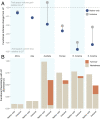Introduced herbivores restore Late Pleistocene ecological functions
- PMID: 32205427
- PMCID: PMC7148574
- DOI: 10.1073/pnas.1915769117
Introduced herbivores restore Late Pleistocene ecological functions
Erratum in
-
Correction to Supporting Information for Lundgren et al., Introduced herbivores restore Late Pleistocene ecological functions.Proc Natl Acad Sci U S A. 2020 Jul 21;117(29):17449. doi: 10.1073/pnas.2012659117. Epub 2020 Jul 13. Proc Natl Acad Sci U S A. 2020. PMID: 32661156 Free PMC article. No abstract available.
Abstract
Large-bodied mammalian herbivores dominated Earth's terrestrial ecosystems for several million years before undergoing substantial extinctions and declines during the Late Pleistocene (LP) due to prehistoric human impacts. The decline of large herbivores led to widespread ecological changes due to the loss of their ecological functions, as driven by their unique combinations of traits. However, recently, humans have significantly increased herbivore species richness through introductions in many parts of the world, potentially counteracting LP losses. Here, we assessed the extent to which introduced herbivore species restore lost-or contribute novel-functions relative to preextinction LP assemblages. We constructed multidimensional trait spaces using a trait database for all extant and extinct mammalian herbivores ≥10 kg known from the earliest LP (∼130,000 ybp) to the present day. Extinction-driven contractions of LP trait space have been offset through introductions by ∼39% globally. Analysis of trait space overlap reveals that assemblages with introduced species are overall more similar to those of the LP than native-only assemblages. This is because 64% of introduced species are more similar to extinct rather than extant species within their respective continents. Many introduced herbivores restore trait combinations that have the capacity to influence ecosystem processes, such as wildfire and shrub expansion in drylands. Although introduced species have long been a source of contention, our findings indicate that they may, in part, restore ecological functions reflective of the past several million years before widespread human-driven extinctions.
Keywords: functional ecology; invasion; megafauna; novel ecosystems; restoration ecology.
Conflict of interest statement
The authors declare no competing interest.
Figures




References
-
- Martin P. S., Klein R. G., Quaternary Extinctions: A Prehistoric Revolution (University of Arizona Press, 1989).
-
- Barnosky A. D., Koch P. L., Feranec R. S., Wing S. L., Shabel A. B., Assessing the causes of late Pleistocene extinctions on the continents. Science 306, 70–75 (2004). - PubMed
-
- Lundgren E. J., Ramp D., Ripple W. J., Wallach A. D., Introduced megafauna are rewilding the Anthropocene. Ecography 41, 857–866 (2018).
Publication types
MeSH terms
LinkOut - more resources
Full Text Sources
Miscellaneous

